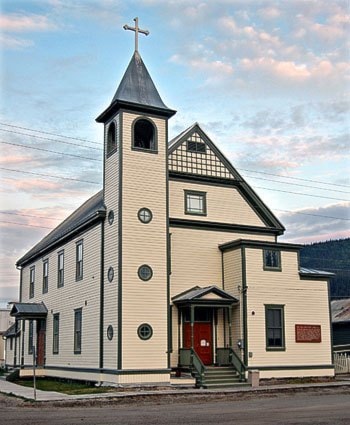The Yukon’s separate Catholic school system happened essentially by accident.
It all started in the late 1890s, when territorial commissioner William Ogilvie was struggling to manage the creation of the new territory in the midst of the chaotic Klondike Gold Rush.
According to a 1983 research paper written by historian Richard Stuart, Ogilvie wanted to create a non-sectarian public school system for the fledgling territory, and to do it he enlisted the help of the clergymen from the four major denominations of the time - Catholic, Anglican, Methodist and Presbyterian.
The idea was to include them all under one system and build a public school in Dawson City. The four had already worked together well in providing other public services, especially health care.
But one clergyman wouldn’t go along with the plan.
“Not surprisingly, it was the Catholic priest, Father Pierre Edmond Gendreau,” Stuart wrote.
“Soon after he had refused to go along with the Protestant ministers in creating a public school, Gendreau petitioned the commissioner for the establishment of a separate school which he had built, supplied and could staff with the Sisters of St. Ann,” Stuart wrote.
That explains how Catholics got a separate school system. But how did they end up getting government funding for it?
As the Catholics were busy doing their own thing, Ogilvie was still trying to establish his public school. He passed a school ordinance and ordered the necessary books and supplies. But then disaster - or an act of God - ruined his plans.
The ship carrying supplies for the new school sank.
“Faced with the prospect of no public school in 1899, the (Yukon) Council announced to the public ... that anyone starting a school would get a grant to maintain it. This announcement was all that Gendreau needed. His refusal to participate in the public school, his initiative in building a separate school and the vagaries of northern shipping meant there would only be one school in Dawson ready in the fall of 1899 - St. Mary’s Catholic School,” Stuart wrote.
Ogilvie’s schools ordinance borrowed heavily from the N.W.T.‘s own territorial ordinance of 1896, with one key difference. Ogilvie’s was only meant as a stop-gap measure, but in 1902 Ogilvie’s successor, James Ross, passed a full ordinance that cemented public funding of denominational schools in Yukon legislation.
While this was all hashed out in the Yukon in 1902, the history of Catholic funding in Canada goes back much further than that.
“The issue actually has its genesis in central Canada in the middle of the 19th century,” explained Mark McGowan, a University of Toronto history professor and expert on Catholic issues.
“One of the key pieces of legislation that provides for these collective rights is the Quebec Act of 1774. You can really do a kind of linear tracing to these collective rights for religious minorities all the way back to the mid-1700s,” McGowan said.
During colonization, the British Empire did something strange, McGowan explained: it passed legislation that protected minority education across the country. At the time, it was meant to both protect Protestants living in Quebec and Catholics living in Ontario.
It’s doubtful anyone thought to consider the impacts that such constitutional precedents would have on minorities centuries later.
Regardless, as Canada expanded west, much of that legislative history came with it, leading ultimately to today’s constitutional protections for collective minority rights.
In another peculiar twist of history, the Yukon’s separate school system actually saved it from annexation by B.C. in the late 1930s.
B.C. has never had the same protections for separate schools, and when politicians in Vancouver - then-premier Duff Pattullo in particular - started salivating about getting their hands on the Yukon’s wealth of natural resources, it was the tricky prospect of also annexing a separate school system that stopped them at the border. No one in B.C. wanted to touch such a controversial issue.
But those same protections now often end up in conflict with individual freedoms as protected by the Charter of Rights and Freedoms. The conflict between Catholic education and the right of individuals to be free from discrimination based on sexual orientation is a perfect example of that, McGowan said.
“It’s an issue that will not go away, and could lead to constitutional challenges. There are sections of the Yukon’s Education Act that reference the individual rights of students. If those were invoked, you would definitely have the basis for a court case,” McGowan said, adding that guessing which way that case would go is impossible to say.
Contact Jesse Winter at
jessew@yukon-news.com
